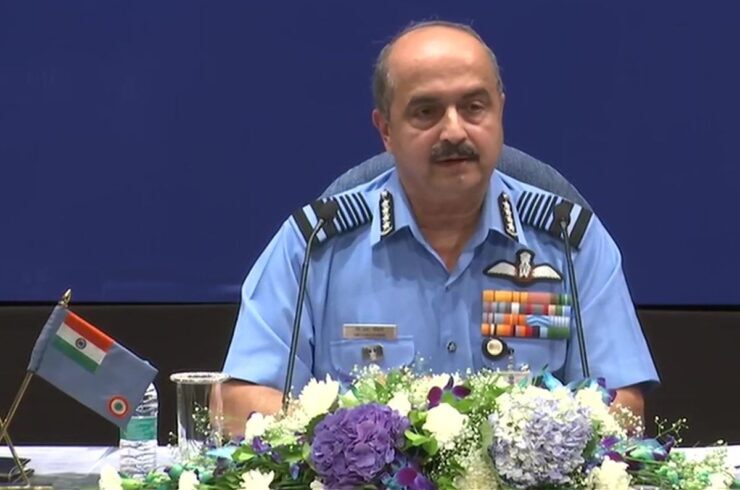
New Delhi: Ahead of the Indian Air Force (IAF) celebrating its 89th anniversary on October 8, the new Chief of Air Staff, Air Chief Marshal V.R. Chaudhuri asserted that the IAF is capable of facing “two front threat” and came out strongly in support of joint planning and operations among the three services.
“We are fully committed to integration and jointmanship. There is no doubt,” he said.
Addressing his first media meet since taking over as the 27th Chief of Air Staff, he made it clear that structures and processes of theaterisation will have to take into account individual strengths and doctrines of the Army, Navy and Air Force.
“We are fully committed to integration and jointmanship. There is no doubt,” Air Chief Marshal Chaudhari said.
He made it clear that the IAF is not just a support arm, and even the Army will have to support the Air Force in its operations.
The Air Chief said Chinese Air Force (PLAAF) is “still deployed at three bases facing eastern Ladakh and that though this forward deployment can change as the Chinese infrastructure development is going on at a very high rate,” but asserted that “it will not make much of a difference for the air force.”
On Pakistan too developing airfields close to the border like China, with special reference to airfields in POK and near Pak-Afghan border, the Air Chief said “we don’t need to get much alarmed about it. Right now, they are small strips capable of taking on a few helicopters.”
The air strips near the Afghanistan border cater to that region, he said. To the oft asked question of a two-front war, the Air Chief said “it always remain a focus for us, and our capability building is dependent on the threat – we are capable, we are prepared in terms of training, in terms of equipment.”
In this context, asked when IAF will have its sanctioned strength of 42 squadrons, he said “that is very tough to say. All I can say is, it won’t be done in the next 10 to 15 years,” but added that by the next decade the IAF will have 35 squadrons. He said the IAF was modernising “to ensure that we retain our technological edge over our adversaries.”
Elaborating on the modernisation drive of the IAF, the Air Chief said “our emphasis would be on cyber warfare, mitigating cyber-attacks and carrying out parallel cyber-attacks with kinetic warfare.”
On the aircraft front, he said IAF is purchasing 83 Light Combat Aircraft (LCA) Mk-1A Tejas, and hopes to acquire six to seven squadrons of the Advanced Medium Combat Aircraft (AMCA) which is under design, and six squadrons of the Multi-Role Fighter Aircraft (MRFA) for which a Request for Information (RFI) for 114 fighter jets have been issued.
He said Rafale is one of the contenders for MRFA and has responded to the RFI. “All I can say is we are very happy with the performance of the aircraft, I would not like to comment further whether that would be the main contender or not,” he said.
On the ongoing debate in the defence establishment over the structures of the theatre command, divisions over which came to the fore during a meeting chaired by Defence Minister Rajnath Singh in June, he said the points raised by his predecessor ACM R.K.S. Bhadauria (Retd) focused on the need for structures and processes to cater for future warfare.
“That is the key element of restructuring into theatres. The strengths of each service need to be taken into account and need to be synchronised for the net combat capability of the nation,” he said. The IAF chief also underlined that the doctrines of each service also need to be kept in mind while designing the structures, and added that his force’s concerns have been considered and deliberations and discussions are on.
“We are hopeful that the ultimate structure that will emerge will cater for joint planning and joint operations in future,” he said.
Asked about the recent remarks of Chief of Defence Staff General Bipin Rawat that the IAF was a “support arm”, the Air Chief said that in any conflict in the world, the air force has had multiple roles. He said the roles vary from offensive strike and air transportation to supporting the army and maritime forces.
“There are various roles for air forces and it is true for the Indian Air Force. Capability of our training and equipment caters to multiple roles,” he said.
ACM Chaudhari underlined that no one service can go alone into any battle, and would “need the support of the other two services. It is true for all services. It is not that just that the IAF only is the support arm, the Army also at times has to support the IAF in its air operations”.
On the charge by a woman officer that she was subjected to the banned two-finger test at the Air Force Hospital, the Air Chief denied the charge saying “the two-finger test, that you mentioned, it is misreported.”
Elaborating on the issue further, he said “the actual fact is that it has not been done. And I can confirm to you that this test was not done. We are all well aware of the rules. All actions, all disciplinary actions that will come out from this inquiry will be taken.” The woman had accused her colleague, a Flight Lieutenant at the Air Force Administrative College in Coimbatore of rape. She told the police that after her complaint she was sent to the Air Force Hospital where two women doctors asked her about her “sexual history,” and that one of the doctors inspected her private parts and conducted the two-finger test.









